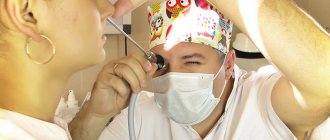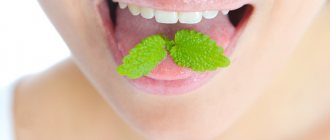Each person normally secretes mucus in the lumen of the bronchi. This mucus protects the bronchi and lungs from dust and infection from the inhaled air. If a person is healthy, then the production of this mucus is not accompanied by a cough. However, when inflammation occurs in the bronchial tree, there is a significant increase in mucus production and a change in its viscosity. A cough occurs and the person coughs up this mucus. Mucous discharge passes through the bronchi, trachea, laryngeal cavity and mouth before leaving our body. This discharge is called sputum. Sputum is also called discharge during inflammatory processes in the upper respiratory tract - nasopharynx, larynx.
The nature of sputum - its color, viscosity, smell - has important diagnostic significance. In classical medicine, there are such artistic descriptions - sputum in the form of “raspberry jelly” (suggests the presence of pneumonia caused by Klebsiella pneumonia). Or canary-colored sputum (may indicate pulmonary aspergillosis). Scarlet sputum may indicate hemoptysis or pulmonary embolism.
For chronic and acute pulmonary diseases, mucopurulent and purulent sputum is most characteristic. The sputum becomes cloudy and yellow instead of clear. Over time, the color of the sputum becomes yellow-green, and later takes on a purulent, green character. Sometimes the sputum has a putrid odor. The physical properties of sputum also change - it becomes viscous and viscous. It is difficult to cough up.
What diseases cause purulent sputum?
Purulent sputum when coughing can appear for various reasons. Mostly this is caused by serious problems in the body, so you should not treat the symptom yourself. Why does a purulent cough appear:
- pneumonia;
- disturbances in lung function;
- bronchitis;
- tuberculosis;
- asthma;
- tumor.
A healthy person may expectorate a small amount of mucus per day. Normally it is transparent and odorless. Depending on its color, sputum indicates the presence of certain diseases. For an accurate diagnosis, you need to see a doctor and undergo the necessary tests. What does yellow-green sputum indicate:
- allergy;
- pneumonia;
- untreated flu;
- asthma;
- bronchitis;
- pharyngitis;
- lung abscess.
Sputum that is rusty, red, or brown:
- pulmonary edema;
- tuberculosis;
- pneumonia;
- lungs' cancer.
A cough with white sputum indicates the presence of a fungal infection or tuberculosis. It is important to remember that self-medication is contraindicated when coughing with purulent sputum. You should immediately seek help from a doctor.
- Cough with sputum - how to treat in adults and children
What gives the yellow-green color to purulent sputum?
The respiratory organs are an open system of tubes devoid of valves, membranes, sphincters, etc. The air we breathe contains microorganisms in addition to organic and inorganic dust. These are viruses, bacteria, fungi. Once inside the respiratory system, they can be removed from it with the help of mucus and villi. In this case, a person will not even feel the presence of foreign objects in the bronchi. But during illness, microbes gain an advantage, multiply quickly, and come into conflict with the human immune system. They die, the protective cells die, and the surrounding tissue is damaged. Complex cytotoxic reactions occur. All these “military” actions lead to a change in the color of sputum. The more pronounced the inflammation process, the more purulent the sputum will become. In chronic long-term processes, sputum acquires a green-brown character and becomes viscous. In this case, the patient may cough up sputum in the form of casts of the bronchi. Green color.
The purulent nature of sputum can occur in acute and chronic lung diseases. In any case, this symptom cannot be ignored. Treatment measures must be carried out quickly and effectively.
Sputum interspersed with dark gray lumps may indicate mold growth or a tuberculosis infection.
The canary-colored sputum is characteristic of pulmonary aspergillosis.
Klebsiella pneumoniae causes a cough with sputum the color and consistency of “raspberry jelly.”
Yellow sputum is characteristic of acute diseases caused by Staphylococcus aureus, streptococci S. pneumoniae, S. pyogenes. Such sputum can occur in any pulmonary disease from acute bronchitis to pneumonia.
Green sputum is more typical for chronic lung diseases; this may be bacterial associations of gram-positive and gram-negative bacteria. Such as Haemophilus influenzae + Staphylococcus aureus. Or Pseudomonas aeruginosa P. aeruginosa in combination with streptococci. Occurs in patients with bronchiectasis, COPD, and cystic fibrosis.
Thick green sputum with an odor indicates a lung abscess, abscess pneumonia. Pathogens can be S. aureus, K. pneumoniae, gram-negative bacilli, Streptococcus pyogenes Haemophilus influenzae.
The presence of blood in the sputum may indicate a pulmonary embolism, cancer, or problems with the larynx.
What to do?
In acute diseases, purulent sputum does not appear immediately, but usually on the 4th day of the disease. If coughing up such sputum is accompanied by an increase in body temperature, then the help of a doctor is necessary. No need to self-medicate!
In COPD, bronchiectasis, and obstructive bronchitis, sputum may become purulent within one to two days. Often green-yellow color of sputum is constantly present in a person suffering from chronic pulmonary diseases. During exacerbations, it becomes intensely green and coughs up large quantities. Patients with chronic lung diseases should have an individual plan prescribed by a pulmonologist for preventive and urgent action in connection with the appearance of purulent sputum. If you do not have such a plan, remind your doctor that you need one. If your active actions do not help within 5-7 days, contact a pulmonologist.
Diseases characterized by purulent sputum
- COPD,
- Bronchiectasis,
- Pneumonia,
- Chronic purulent obstructive bronchitis,
- Lung abscess, abscess pneumonia,
- Pulmonary tuberculosis,
- Cystic fibrosis,
- Purulent processes in the nasopharynx,
- Pulmonary aspergillosis,
- Non-tuberculous mycobacteriosis.
Diagnostics
Diagnosis of diseases of the respiratory organs leading to expectoration of purulent sputum is a set of measures that includes examination, auscultation, and percussion of the chest.
Mandatory x-ray examination. Computed tomography of the chest organs (CT CT) is considered more informative.
Functional breathing tests - respiratory function, body plethysmography and diffusion tests are often necessary.
Sputum examination is an important stage for prescribing treatment and assessing the prognosis of the disease. Routine sputum tests are important to assess the severity of inflammation (by counting the number of leukocytes in the sputum) and eosinophils. A general sputum test can help identify Mycobacterium tuberculosis. Fragments of mycelium or pseudomycelium of fungi.
The microbiological method (sputum culture) answers the question of what is the name of the microorganism that causes purulent, mucopurulent inflammation in the lung tissue. The sputum is sown on special nutrient media, the colony is counted and the name of the pathogen is determined. Detection of H. influenzae, M. catarrhalis and S. Pneumoniae.
For example, risk factors for Pseudomonas infection include recent hospitalization (2 days within the past 90 days), frequent use of antibiotics (4 courses within the past year), severe COPD, isolation of P. aeruginosa during a previous exacerbation, stable period of Pseudomonas colonization, and systemic use of glucocorticoids.
It will require the prescription of antibiotics aimed at destroying these particular microorganisms.
How can we help?
First, it is necessary to treat the disease leading to cough with purulent sputum. Be it an acute or chronic disease. The presence of hemoptysis is an urgent reason to consult a doctor.
- If the disease is caused by bacterial flora, then antibacterial drugs are prescribed.
- If we are dealing with influenza and bacterial pneumonia that has developed against it, a combination of antiviral drugs and antibiotics is needed
- If the cause of purulent sputum is a fungal infection, then it is necessary to treat with antifungal drugs
- If tuberculosis is detected, then use anti-tuberculosis drugs.
For a rapid response to treatment, bronchoscopy may be effective. These are manipulations in which a flexible endoscope is inserted into the bronchus, which sucks out purulent sputum from the bronchi, and with the help of it you can pour an antiseptic and antibiotic into the bronchus. But the method is traumatic, unpleasant and dangerous with complications.
An alternative to bronchoscopy can be considered hardware coughing technologies - intra-alveolar percussion devices, vibration vests, exercise therapy sets, breathing simulators and coughers for home use.
Treatment methods
To begin treatment of cough and its root cause, the patient first needs to undergo the necessary tests. It can be:
- radiography;
- blood and urine tests;
- sputum analysis;
- bronchoscopy;
- spirography.
The doctor also conducts a visual examination and only then prescribes medications to improve expectoration of mucus. In addition to them they use:
- Physiotherapeutic procedures;
- Therapeutic gymnastics;
- Acupuncture;
- Immunomodulators;
- Massage;
- Surgical intervention.
Medicines used to treat this symptom are divided into the following categories:
- antibiotics;
- antiviral drugs;
- mucolytics;
- bronchodilators;
- anti-inflammatory drugs;
- homeopathic medicines;
- complex medicines.
The patient should drink frequently and a lot, give up smoking and alcohol, walk and breathe fresh air every day, and eat right.
Oral diseases
The appearance of an unpleasant rotten or rotten odor, both with and without a cough, may indicate oral diseases or insufficient hygiene. Irregular brushing of teeth leads to the appearance of plaque on them, as well as rotting food particles that remain in the small crevices of the oral cavity even several hours after eating. The unpleasant odor from the mouth becomes especially pronounced after sleep.
Other causes of odor include the following oral diseases:
- Stomatitis,
- Caries,
- Gingivitis,
- Tartar, formed from plaque due to insufficient oral hygiene,
- Gum abscess,
- Periodontal disease.
Pathologies of the oral cavity often become causes of disruption of the gastrointestinal tract. This is possible because, passing through diseased teeth, food carries some pathogenic microorganisms into the stomach.
- How to treat a dry cough in an adult that lasts for a long time without fever
ENT pathology
Almost all ENT diseases arise as a result of exposure to pathogenic microorganisms on the mucous membrane. These can be either viral or bacterial, most often coccal, infections. When they infect the human mucosa, they actively multiply in it. The result of the vital activity of pathogenic microflora is the appearance of purulent inflammation.
The main ENT diseases that provoke the appearance of cough with an unpleasant odor and pus are:
- Sinusitis. Pus accumulates in the maxillary sinuses and remains there constantly,
- Tonsillitis. It is characterized by inflammation of the tonsils and the appearance on their surface of accumulations of pus, consisting of dead bacteria, dead epithelial cells and leukocytes.
The appearance of small, foul-smelling lumps when coughing most often indicates tonsillitis. With sinusitis, pus is most often excreted in sputum.
Diabetes
The appearance of a cough with a specific odor from the oral cavity is also possible with diabetes. In this case, the cough itself occurs due to constant dry mouth that accompanies the pathology, and the foul odor is a reaction to dehydration.
In diabetes mellitus, cough may be accompanied by the aroma and taste of acetone. This phenomenon occurs when the mucous membranes are dry due to fasting or lack of fluids, especially with excessive sweating.
Diseases of the gastrointestinal tract
A foul odor, as well as a cough, can occur in a person due to slow digestion, low acidity of gastric juice, and also due to rotavirus infection. The smell of rotten eggs occurs when coughing and belching due to fermentation and rotting of undigested food. Coughing in such cases is often accompanied by the flying out of small lumps of rotting food. The pathology may also be accompanied by vomiting.
Sour belching and a cough with a sour smell may indicate gastritis or a peptic ulcer of the stomach or duodenum.
What is phlegm needed for?
Sputum is the secretion of the tracheobronchial tree separated by expectoration mixed with saliva. Its purpose is to remove dust and microbes from the bronchi that enter the body when inhaled. Additionally, this mucus contains immune cells that help fight germs.
Inside, the bronchi are covered with epithelium with cilia, which, when moving, help clear the airways of mucus. In a healthy body, the amount of sputum produced is approximately 100 ml per day. In this case, it is swallowed unnoticed by the person and does not lead to any unpleasant sensations. If pathological processes occur in the body, then the amount of mucus produced sometimes increases to 1500 ml per day. Moreover, each disease is accompanied by sputum of a certain color.
Where can I buy
Antibiotics for coughs with purulent sputum
If a doctor has prescribed antibiotics to a patient, the entire course must be taken. Do not change the dose or duration, even if there is an improvement in the condition. Take antibiotics in tablet form or intravenously. Only in fairly complex cases, the doctor may prescribe several types of antibiotics. What medications are prescribed:
- What you can do for a cough while breastfeeding: syrups, lozenges, tablets
- Trifamox;
- Amoxiclav;
- Clindamycin.
Each drug acts on different bacteria. Therefore, before prescribing a course, you need to conduct an analysis of the bacterial flora. When coughing with purulent sputum, you need drugs with a strong effect. You should not take antibiotics very often. Bacteria become accustomed to them, which reduces their effectiveness. Also, these medications have a number of side effects and contraindications. It is advisable to take them with probiotics - drugs that normalize the functioning of the intestinal microflora.











